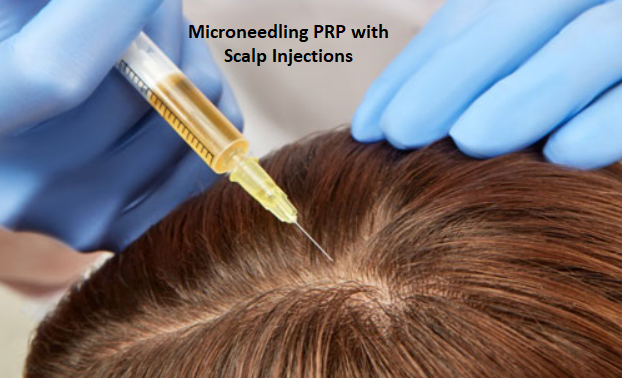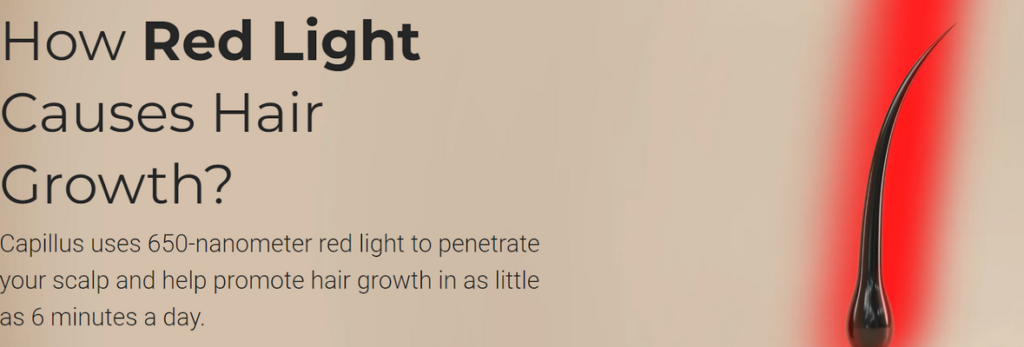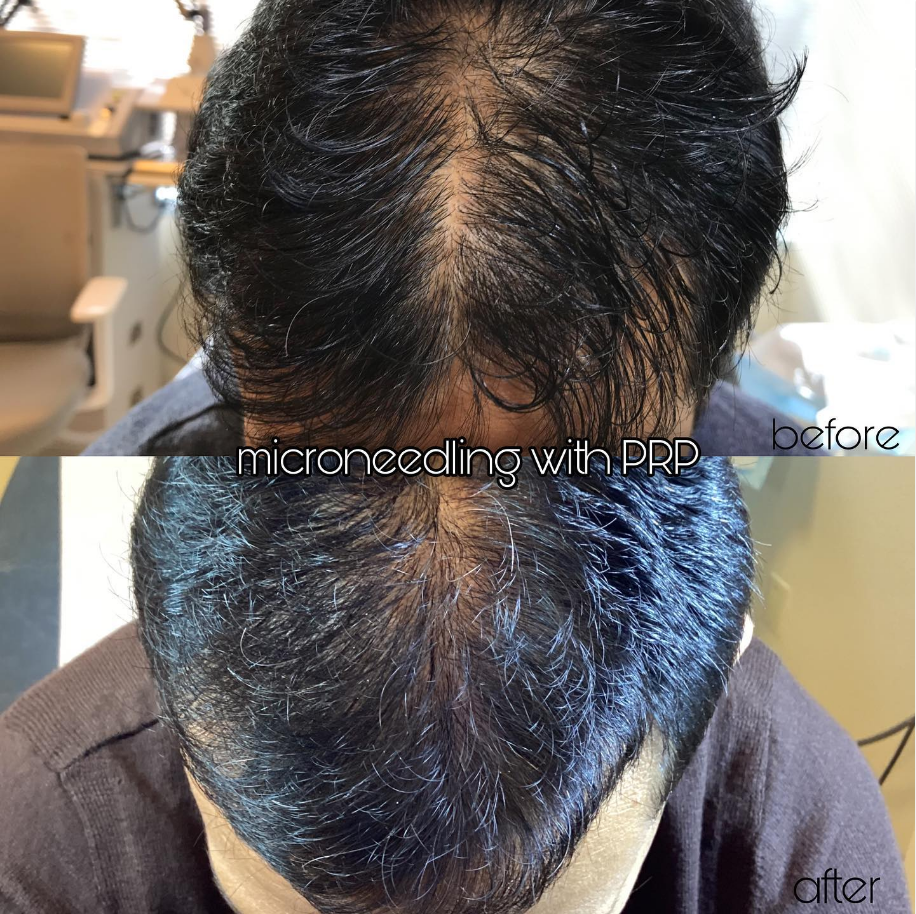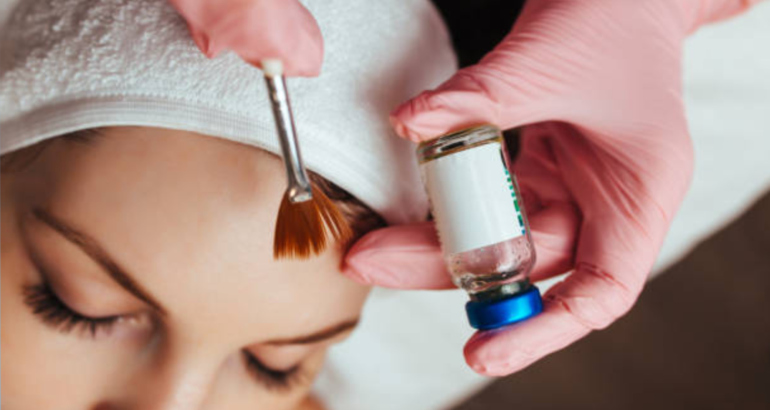Hair Restoration Treatment

We do Microneedling PRP using FDA-approved RejuvaPen with PRP injections for hair restoration. We will do an initial consult and send you pre-care instructions so that you can prep your body for the treatment and produce the best PRP. During this treatment, the clinician will take 60-80ml of blood from your body and add SuperShot if you opted for it. We will then use the well-researched and state-of-the-art method of the double spin method to create PRP. This double spin method generates a very highly concentrated PRP which is ideal for hair loss treatment. We do provide patients with the option of adding Supershot PRP to the treatment to make it more effective.
Our results: Microneedling PRP Hair Restoration Before and After
How to prepare for the Microneedling PRP Hair Restoration treatment?
- Exercise: 20 mins of exercise e.g., Pedaling on a stationary bike prior to the blood draw for PRP increases the yield of platelets in PRP.
- You can take supplements like:
- Stem Cell mobilizing: NICOTINAMIDE RIBOSIDE (NR or NAD+) and l-Arginine: both supplements increase the production of nitric oxide which in turn mobilizes stem cells from bone marrow to the peripheral circulation.
- Blood Sugar Control: Cinnamon, Chromium, Berberine
- Antioxidants: Green tea extract, Resveratrol
- Avoid any Anti-inflammatory medications: It has been noted that the proliferation of endothelial cells and formation of new blood vessels is suppressed by platelets treated with ASA before thrombin stimulation. Also, for the body to elicit a paracrine cascade reaction, there must be a potential for an inflammatory response. This implies we should avoid any /or all these medications/supplements for at least 2 weeks before and at least 2 weeks after the PRP draw:
- NSAIDs
- Oral Corticosteroids
- Turmeric
- Curcumin
- Omega 3 Fish Oil
Also, there should be no steroid injections for at least 90 days prior in the joints being treated.
Why do we lose hair?
Keratin is a tough protein that forms hair. A hair follicle anchors each hair into the skin. The base of the hair follicle is formed by the hair bulb where living cells divide and grow to build the hair shaft. Blood vessels nourish the cells in the hair bulb, and deliver hormones that modify hair growth and structure at different times of life.
Dihydrotestosterone (DHT) is a product of testosterone and estrogen metabolism and it causes shrinkage and miniaturization of hairs. When blood vessels supplying blood to hair follicles are dilated, DHT is flushed out thus preventing miniaturization. Hence, most of the treatment modalities for hair regeneration are targeted at improving the blood supply to the hair follicle.
What determines the amount of hair loss?
The amount of hair loss is determined by the amount of DHT made in our body and the sensitivity of our tissues to that DHT. Both factors are determined by our genes. The actual amount is a less significant issue than the sensitivity of cells to the available DHT. Hence, the most common cause of hair loss across all ages and genders is ANDROGENETIC.
What is the other factor causing hair loss?
The second most common cause is diseased state/stress for example post-covid. Whenever the body is undergoing stress or disease, there is decreased blood supply to hair, skin, and nails causing increased vascular shrinkage, and increased effect of DHT on hair follicles thereby increase in hair shedding.
What are the phases of hair growth?
Hair growth occurs in cycles consisting of three phases:
- Anagen (growth phase): Most hair grows at any given time. Each hair spends several years in this phase.
- Catagen (transitional phase): Over a few weeks, hair growth slows and the hair follicle shrinks.
- Telogen (resting phase): Over months, hair growth stops and the old hair detaches from the hair follicle. A new hair begins the growth phase, pushing the old hair out.
- Hair grows at different rates in different people; the average rate is around one-half inch per month. Hair color is created by pigment cells producing melanin in the hair follicle. With aging, pigment cells die, and hair turns gray.

BY THE TIME YOU HAVE NOTICED HAIR LOSS: YOU HAVE ALREADY LOST 50% HAIR
What is the common type of Alopecia or hair loss?
Some Common Alopecia Types:
- Androgenic alopecia. This is common for women and men. It is also known as male- or female-pattern hair loss.
- Male pattern baldness: The most common type of hair loss in men. Male pattern baldness usually includes either a receding hairline, hair loss at the crown, or both.
- Female pattern baldness (Christmas tree pattern): In women, hair loss usually includes uniform thinning across the scalp, with a preserved hairline. The crown may be affected, but hair loss rarely proceeds to baldness as in men
- Alopecia areata. This is also known as patchy baldness. The bald patches can show up anywhere on your body, but many people get a round or oval patch on the scalp. It is a type of autoimmune disease—your immune system attacks your hair follicles by mistake, causing non-scarring hair loss. The condition most commonly presents with discrete, smooth patches of alopecia on the scalp but may also occur in other hair-bearing areas, such as the eyebrows, eyelashes, beard, and extremities
- Alopecia totalis: Alopecia totalis affects both men and women. It is a more advanced form of alopecia areata that causes hair loss on the face and entire scalp. The chances of alopecia areata resolving itself after reaching the alopecia totalis stage are small, although in some isolated cases, hair follicles can start to grow again
- Alopecia Universalis: The most advanced form of alopecia areata, alopecia universalis usually presents itself later in life and occurs in both men and women. This condition results in total hair loss all over the entire body and is caused by a chromosome mutation at birth.
- Traction alopecia. This is caused by putting stress on hair through repeated pulling or stretching. You can develop this condition if you often wear your hair in a tight ponytail, buns, dreadlocks, hair extensions, weaves, or braids,” says Armani. “In time, the continuous pulling can damage hair follicles. If the damage due to pulling persists, it can cause permanent hair loss.”
- Cicatricial alopecia. This is a “scarring” type of alopecia. It involves inflammation that destroys hair follicles. The destroyed follicles get replaced by scar tissue, resulting in permanent hair loss in the area. Sometimes the condition brings on symptoms like itching, pain, and a sensation of heat.
What are the types of Alopecia that are difficult to treat Alopecia?
- Telogen Effluvium: This condition is generally triggered by stages of stress or trauma (such as childbirth, bereavement, and serious illness) and results in an excessive amount of hair loss, with 30% or more of scalp hair shifting to the telogen (shedding) phase – three times the normal amount4. This is a temporary condition and hair regrowth is therefore to be expected. Adopting a balanced and nutritious diet helps to support healthy regrowth; a poor diet lacking essential vitamins for the hair can prevent it from obtaining the nutrients it needs to thrive.
- Anagen Effluvium: Normally caused by cancer treatment drugs, anagen effluvium results in patchy hair loss and eventually a total loss of hair (it usually grows back after treatment ceases).
- Frontal Fibrosing Alopecia: This condition is characterized by hair loss and scarring on the scalp near the forehead. Around half of all people affected by frontal fibrosing alopecia also experience a loss of eyebrows too and, in some cases, eyelashes10.
What is the treatment of Androgenetic Alopecia?
- Dutasteride — Dutasteride, an inhibitor of both type 1 and type 2 ,5-alpha-reductase and is utilized for the treatment of benign prostatic hyperplasia at a dose of 0.5 mg/day . It is prescribed as an off-label treatment for androgenetic alopecia. Compared with finasteride, dutasteride is three times more potent of an inhibitor of 5-alpha-reductase type 2 and 100 times more potent of an inhibitor of 5-alpha-reductase type 1. Serum DHT concentrations are reduced by 93 to 94 percent with 0.5 mg/day of dutasteride compared with around 70 percent with 5 mg/day of finasteride
- Light therapy — Low-level laser light therapy (LLLT- red light with wavelength 650 nm, non-ablative laser) may benefit men with androgenetic alopecia as well psoriasis. Proposed mechanisms include increase blood supply to hair follicles, acceleration of cellular mitosis, stimulation of hair follicle stem cells or follicular keratinocytes, effects on cell metabolism leading to increased adenosine triphosphate production and cellular activity, and anti-inflammatory effects.


Once the cap turns on, red laser light lights illuminate your scalp. The photo biomodulation process is how our cells react to red light, and how we can use this reaction to help grow healthier hair.
Microneedling PRP with scalp injections for hair restoration treatment
What are the different types of HAIR BOOSTERS or treatments we can use?
- MICRONEEDLING with PRP and PRP injections- It is a treatment where we use FDA-approved Rejuvapen to make small pores in your scalp and then apply PRP topically and inject it into the scalp using tiny thin needles. Do not worry you will not feel much pain as we use stress balls, skin vibrators, and numbing spray to numb your scalp. We use Platelet-rich plasma (PRP) with double spin for this process.
- Super PRP – the body’s own exosomes mixed with PRP
- EXOSOMES: external growth factors, stem cells derived from placental tissue, FDA-approved only for topical application
What is the efficacy of Minoxidil?
10% MINOXIDIL can be used to prevent hair loss but FDA does not approve it
Is the Microneedling PRP with PRP injection treatment painful?
We use stress balls, skin vibrators and numbing spray to numb your scalp. Most of the patients can bear the discomfort without any issues.
What are the results for Microneedling PRP with PRP injection?
We have performed many of these treatments so far, and the results have been amazing. You can check our Instagram page for hair restoration results.
What are the recommended boosters for an average healthy person with no hair loss but worries it might happen due to risk factors?
- Nutrafol
- Viviscal
- Biotin
- Rogaine
- Private branded topicals
- Shampoos and Conditioners: You can use any hair loss shampoo. We recommend Ontogeny C from RefineUSA as it has Adipose stem cells. We are the authorized reseller of Ontogeny C.

A breakthrough blend of regenerative cytokines, polypeptide complexes, and potent growth factors derives from human stem cells.
How Ontogeny C works?
Your skin cells are continuously undergoing repair. This remodeling, correcting, and regenerating requires multiple cellular processes to work synergistically. That is where Ontogeny C comes in. Our scientists carefully culture human stem cells to enable your skin to regenerate and fight the visible signs of aging.
Ontogeny C provides your skin with the components that are naturally lost through the aging process. Ontogeny C scientists have developed a process to isolate the cytokines and growth factors that are vital to maintaining your skin’s appearance. Ontogeny C resupplies your skin with these powerful missing factors. Ontogeny C promotes cell renewal, boosts the production of collagen and elastin production, restores aging cells, and ultimately provides you with more youthful-looking skin.
What is Microneedling?
Micro-needling creates tiny holes across the skin with a handheld microneedling pen.
These holes – each the size of a needlepoint – penetrate the dermal layer at a deep depth enough to stimulate cell growth and increase circulation but not to cause damage.
As the holes are minuscule, there is little to no pain involved.
Micro-needling causes collagen regeneration, encourages the body to produce more cells, and increases blood flow to the treated area. Both responses are integral to regrowth.
Micro-needling mirrors the process of wound recovery, which involves three distinct stages:
- (a) Inflammation
- (b) Proliferation
- (c) Re-modeling
When dealing with a genuine wound, the body’s defense systems activate.
They accelerate cell production to ensure the injury heals quickly.
The new cells are fresh, damage free, and appear smoother and younger.
Micro-needling manipulates this natural process to improve the appearance of scars, wrinkles, and dermatological conditions.
All it does is trick the body into thinking there is a wound by creating pin-prick holes across the surface of the skin.
We use FDA approved micro-needling pen called REJUVAPEN NXT which has 12 stainless steel needles rotating at 12000rpm = 144000 microchannels per minute = 3 million microchannels per treatment.
How does Microneedling PRP Hair Restoration treatment work?
PRP hair loss treatments use a concentrated amount of your own plasma to regenerate cells and promote healthy hair growth.

We do both PRP Microneedling and PRP scalp injections for Hair Restoration Treatment



What is a SUPER PRP?
These are exosomes derived from your own cells. Since they are autologous, we can inject them into the scalp. When injected into the scalp, the result is thicker, healthier hair by the delivery of over 1-10 billion growth factors to affected areas. We combine PRP with super shots (autologous exosomes) to prepare a SUPER PRP which is highly potent and effective in boosting hair growth.
Should I add topical treatments when Microneedling?
Allow for 24 hours either side of the needling when applying topical treatments (increased risk of side effects due to enhanced systemic absorption)
What to expect after the Microneedling with PRP treatment?
- After micro-needling for the first time, it is normal for the scalp to feel slightly tender and inflamed immediately after the procedure. It may appear red and feel a little tingling. It is rare, but these sensations can continue for up to 24 hours after micro-needling.
- Can it damage existing follicles? Yes, but it is almost always a consequence of awkward handling.
Attempting to microneedle in an area that is healthy and already has good hair coverage is not recommended.
What are the side effects of Microneedling on the head?
Microneedling itself may cause:
- bruising
- oozing from the wounds
- redness
- swelling
- pain
- Microneedling also is not recommended for women who are pregnant.
- Using minoxidil immediately after Microneedling can increase the absorption of the medication and cause more burning, itching, and irritation on the scalp. It is important to talk to your healthcare provider about when you should resume your topical minoxidil after treatment.
- Your scalp may be more sensitive to the sun after treatment. Wearing sunscreen every day is recommended. A hat can also help protect your scalp when outdoors.
- Another risk of Microneedling on your head is the possibility of infection. While the needles are small, they are still inflicting wounds.
- You will need to follow your aftercare instructions carefully to prevent infection. Your aftercare often involves keeping the area clean for a few days.
Supershot PRP
What is Supershots® PRP?

SuperShot® PRP is a process that concentrates the plasma EVs in PRP. By performing one additional spin of the platelet-poor plasma (PPP), SuperShot® enables the precipitation of low-density lipid-based EVs. Many of the EVs concentrated by SuperShot® are exosomes.
All PRP contains EVs (including exosomes). Using SuperShot® in the PRP process increases the content of EVs by concentrating them.
Supershot is a patented chemical that acts like a surfactant and coats and binds to plasma EVs and enables them to be suspended to plasma.
Why doesn’t the standard PRP process concentrate extracellular vesicles?
EVs are not dense enough to be isolated by clinical centrifuges, which typically spin at 1000-5000 RPM speeds. To precipitate EVs by centrifugation alone, speeds of >100,000 RPM are required, and it takes several hours. Standard PRP contains EVs but are not concentrated above the patient’s basal plasma levels by the normal PRP process.
How does SuperShot® work?
SuperShot employs a physics technique to change the dynamics of plasma centrifugation. The addition of polyethylene glycol (PEG) and a high-weight Dextran (Dex) to plasma creates an aqueous two-phase system that decreases the solubility of low-density lipids (such as EVs). The EVs can then readily be pelleted at tabletop centrifuge speeds.
Is the SuperShot solution included in the final SUPER PRP?
No. The PEG/Dex in SuperShot® solution remains in the depleted PPP, which is discarded. Both the PEG and Dex remain soluble in the PPP. Only the pelleted EVs are added to the PRP.
Is SuperShot PRP autologous?
Yes. The SuperShot® process concentrates EVs that are in the patient’s plasma. Like concentrating platelets, SuperShot® concentrates what is already in the patient’s blood.
Are plasma extracellular vesicles a therapeutic component of PRP?
This is an open question. PRP is relatively new, and its therapeutic components are still being elucidated. However, pre-clinical evidence suggests that plasma-derived EVs (including exosomes) have therapeutic value. Here are some recent studies of plasma EVs in animals:
- Exosomes Isolated from Platelet-Rich Plasma and Mesenchymal Stem Cells Promote Recovery of Function After Muscle Injury: https://pubmed.ncbi.nlm.nih.gov/32543878/
- Plasma exosomes protect the myocardium from ischemia-reperfusion injury: https://pubmed.ncbi.nlm.nih.gov/25881934/
- Exosomes derived from platelet-rich plasma promote the re-epithelization of chronic cutaneous wounds via activation of YAP in a diabetic rat model: https://pubmed.ncbi.nlm.nih.gov/28042318/
- Plasma-Derived Exosomes Boost the Healing of Irradiated Wound by Regulating Cell Proliferation and Ferroptosis: https://pubmed.ncbi.nlm.nih.gov/33653500/
- Exosomes derived from human platelet-rich plasma prevent apoptosis induced by glucocorticoid-associated endoplasmic reticulum stress in rat osteonecrosis of the femoral head via the Akt/Bad/Bcl-2 signal pathway: https://pubmed.ncbi.nlm.nih.gov/28255363/
Could the therapeutic effect of plasma extracellular vesicles vary between patients?
Almost certainly. As mentioned above, the individual therapeutic components of PRP itself have not been well-established; however, there is evidence that the effect of PRP varies between patients. If plasma EVs underpin the effects of PRP, then this effect would also be expected to vary between patients.
As all physicians that employ PRP are aware, different PRP systems and processes result in different PRP preparations. PRP preparations vary in concentrations of leukocytes, RBCs, platelets, proteins, etc., and these vary within the same patient preparation.
The SuperShot® PRP process enables the concentration of EVs in the PRP preparation.
Most physicians that use PRP clinically believe that more clinical trials to test applications and various PRP preparations will improve PRP therapy. The new ability to concentrate the EV component in PRP preparation should also warrant consideration in clinical investigations.
Why are plasma extracellular vesicles interesting?
Cells release EVs that efficiently transfer their molecular cargo to other cells. Plasma is rich in exosomes, a type of EV, and it is known that exosomes mediate many physiological functions, including inflammation, angiogenesis, and wound healing. Exosomes contain non-coding RNAs (such as microRNAs) that potently affect acceptor cells that take up the exosomes.
Unlike proteins used by cells as functional molecules, non-coding RNAs in exosomes can modulate gene expression in acceptor cells. Exosomes have generated considerable clinical interest over the past decade, with hundreds of clinical trials testing their therapeutic application.
What is the regulatory status of SuperShot PRP?
Per the FDA guidance, PRP is considered a blood product “Regulatory Considerations for Human Cells, Tissues, and Cellular and Tissue-Based Products: Minimal Manipulation and Homologous Use”; July 2020, Section V.A, pg. 22: “…for example, platelet-rich plasma (PRP, blood taken from an individual and given back to the same individual as platelet-rich plasma) is not an HCT/P under 21 CFR Part 1271 because it is a blood product.”
SuperShot® PRP is a PRP preparation, according to the FDA’s guidance:
- It is a blood product
- It is autologous
- It is removed from an individual and implanted into the same individual in the same surgical procedure,
- It does not include intervening processing steps beyond rinsing, cleansing, sizing, or shaping, and
- It raises no additional risks of contamination and communicable disease transmission beyond that typically associated with surgery.
Does the SuperShot® isolated fraction contain exosomes?
Yes. The plasma is rich in exosomes, and exosomes are EVs that range between 30-150nm in diameter. Many analyses have demonstrated that the SuperShot® isolated fraction is rich in exosomes; indeed, they may be the most abundant EV present. However, there are other EVs isolated by SuperShot® as well, some ranging up to 450nm in size. For example, some EVs are likely platelet-derived microvesicles larger than exosomes. Different processes create some EVs. However, the characterization of EVs often depends upon the context in which they are studied.
Exosomes are some of the best-studied EVs, constituting many, if not the majority, of EVs isolated in the SuperShot® fraction. For this reason, we often speak to the exosomes isolated by SuperShot®. That said, the SuperShot® process isolates all low-density EVs from the PPP.
Light therapy – Capillus Laser Caps
What happens when the scalp absorbs red light?
Within the mitochondria, red light stimulates an enzyme known as cytochrome c oxidase. This causes your mitochondria to produce more energy, or Adenosine triphosphate (ATP). This extra energy enables the body to repair damaged tissues and send vital nutrients to your hair follicles, restarting the growth process.
What happens to the blood vessels?
Red light can also cause your blood vessels to expand – increasing blood flow throughout your scalp. Pair this with the accelerated production of ATP; now, lots of energy and resources are available to grow new hair.
How does the red light help with hair restoration?
Within the mitochondria, red light stimulates an enzyme known as cytochrome c-oxidase. This causes your mitochondria to produce more energy, or Adenosine triphosphate (ATP). This extra energy enables the body to repair damaged tissues and send vital nutrients to your hair follicles, restarting growth.
WE RECOMMEND CAPILLUS LASER HAIR CAPS: AVAILABLE FOR PURCHASE THROUGH US. No refund or exchange can be provided on this once sold.
How long should I use laser hair caps?
Lifelong as hair loss is a lifelong process. Affect start in 3-6months, results within 6-12 months

How often do I need to wear a laser hair cap?
6 minutes each day. Continuous wave technology allows for even laser energy distribution throughout the treatment session.
Are Capillus Hair caps safe?
Yes. Capillus technology uses a special low-level laser light that operates at 650nm. This wavelength of light is a visible red light. Red laser energy is restorative and does not damage skin cells. Rather, light is absorbed by the skin without causing any pain or discomfort. The US FDA approved Capillus devices as a safe treatment for androgenetic alopecia.
Are Capillus laser hair caps hot?
No. Capillus lasers are cool to the touch, meaning your LLLT treatment will be comfortable. In fact, LLLT (low-level laser therapy) is also known as cold laser therapy. Some users have reported a slight increase in temperature to the treatment area, but this is safe during treatment and is most likely a result of heat naturally emitting from the covered scalp.
What other Aesthetic and skincare services do you provide?
You can visit our Medical Spa services page to look at our services.
How can I book an appointment and look at the prices for all your Medical Spa services?
You can visit the book online page to book an appointment and check our service prices.




